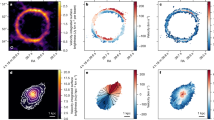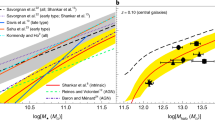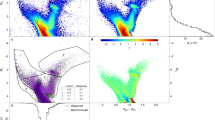Abstract
AS in the case of other spiral galaxies, such as M31 (refs 1, 2), the rotation curve of gas in our Galaxy indicates that its nuclear bulge is triaxial3. Despite several studies4,5 of the distribution of specific objects in the galactic bulge, no observational evidence of asymmetry has emerged. Recently, however, Blitz and Spergel6 have reanalysed balloon-infrared observations at 2.4 μm, where obscuration is relatively low, to suggest that the galactic bulge is bar-like, and tilted with respect to the plane of the Galaxy. Here we report that the distribution of IRAS (the Infrared Astronomy Satellite) bulge stars shows an asymmetry with respect to the Galactic Centre, providing clear evidence for triaxiality.
This is a preview of subscription content, access via your institution
Access options
Subscribe to this journal
Receive 51 print issues and online access
$199.00 per year
only $3.90 per issue
Buy this article
- Purchase on Springer Link
- Instant access to full article PDF
Prices may be subject to local taxes which are calculated during checkout
Similar content being viewed by others
References
Stark, A. Astrophys. J. 213, 368–373 (1977).
Gerhard, O. E., Vietri, M. & Kent, S. M. Astrophys. J. 345, L33–36 (1989).
Gerhard, O. E. & Vietri, M. Mon. Not. R. astr. Soc. 223, 377–389 (1986).
Harmon, R. & Gilmore, G. Mon. Not. R. astr. Soc. 235, 1025–1047 (1988).
Whitelock, P., Feast, M. & Catchpole, R. Mon. Not. R. astr. Soc. 248, 276–312 (1991).
Blitz, L. & Spergel, D. N. Astrophys. J. (in the press).
Kinman, T. D., Feast, M. W. & Lasker, B. M. Astr. J. 95, 804–820 (1988).
Maihara, T., Oda, N., Sugiyama, T. & Okuda, H. Publ. astr. Soc. Japan 30, 1–19 (1978).
Matsumoto, T. et al. AIP Conf. No. 83 (eds Riegeler, G. R. & Blandford, R. D.) 48–52 (AIP, New York, 1982).
Habing, H. J. et al. Astr. Astrophys. 152, L1–4 (1985).
Habing, H. J. The Galaxy (eds Gilmore, G. & Carswell, P.) 173–197 (Reidel, Dordrecht, 1987).
Joint IRAS Science Working Group IRAS Point Source Catalogs (US Government Printing Office, Washington DC, 1985).
Rowan-Robinson, M. & Chester, T. Astrophys. J. 313, 413–419 (1987).
Burton, W. B. & List, H. S. Astrophys. J. 225, 815–842 (1978).
Rieke, G. H. & Lebofsky, M. J. Astrophys. J. 288, 618–621 (1985).
Hiromoto, N. et al. Astr. Astrophys. 139, 309–312 (1984).
Frogel, J. A. Ann. Rev. Astr. Astrophys. 26, 51–92 (1988).
Blitz, L. & Spergel, D. Astrophys. J. 370, 205–224 (1991).
Author information
Authors and Affiliations
Rights and permissions
About this article
Cite this article
Nakada, Y., Degucji, S., Hashimoto, O. et al. Is the bulge of our Galaxy triaxial?. Nature 353, 140–141 (1991). https://doi.org/10.1038/353140a0
Received:
Accepted:
Issue Date:
DOI: https://doi.org/10.1038/353140a0
Comments
By submitting a comment you agree to abide by our Terms and Community Guidelines. If you find something abusive or that does not comply with our terms or guidelines please flag it as inappropriate.



